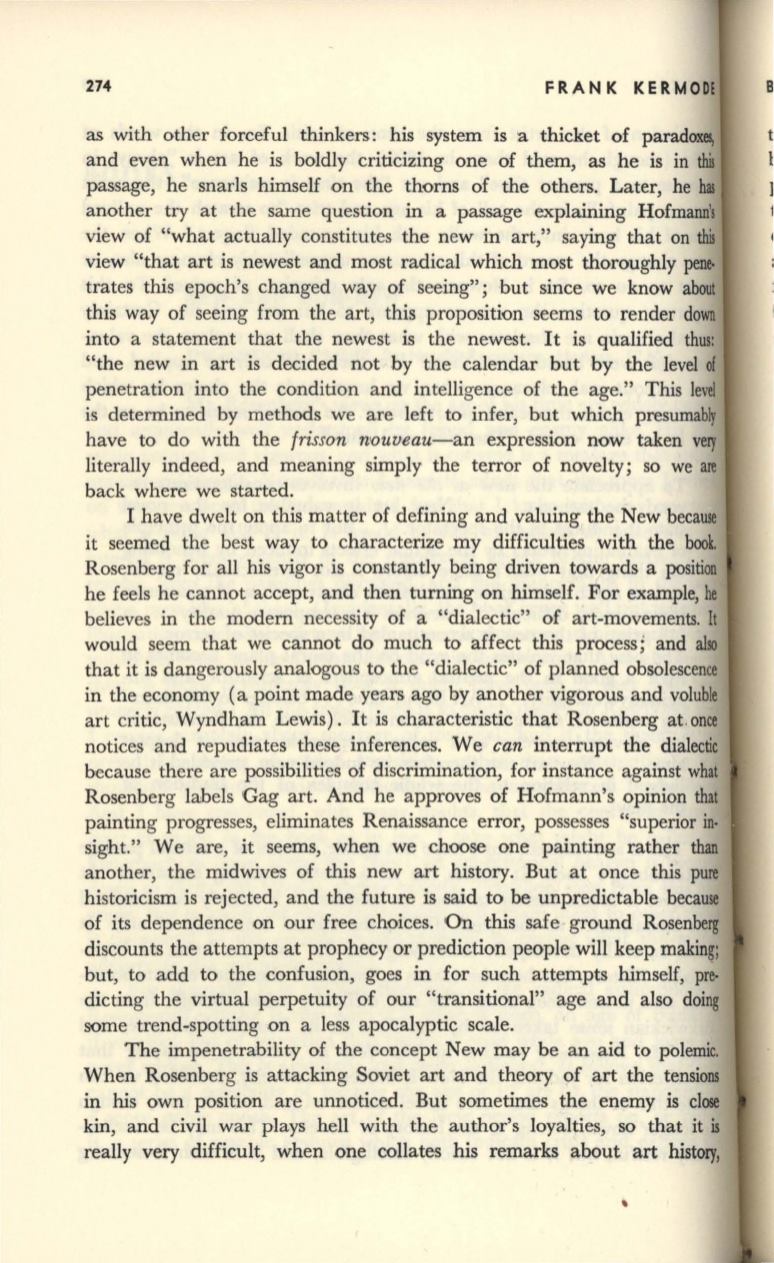
274
FRAN K KERMODE
as with other forceful thinkers: his system is a thicket of paradOlll'.\
and even when he is boldly criticizing one of them, as he is in
tbi
passage, he snarls himself on the thorns of the others. Later, he
hal
another try at the same question in a passage explaining Hofmann'.
view of "what actually constitutes the new in art," saying that on
tbi
view "that art is newest and most radical which most thoroughly
pene–
trates this epoch's changed way of seeing"; but since we know
aboot
this way of seeing from the art, this proposition seems to render down
into a statement that the newest is the newest.
It
is qualified thus:
"the new in
art
is decided not by the calendar but by the level
u
penetration into the condition and intelligence of the age." This leva
is determined by methods we are left to infer, but which presumably
have to do with the
frisson nouveau-an
expression now taken
very
literally indeed, and meaning simply the terror of novelty; so we m
back where we started.
I have dwelt on this matter of defining and valuing the New because
it seemed the best way to characterize my difficulties with the
book.
Rosenberg for all his vigor is constantly being driven towards a
positioo
he feels he cannot accept, and then turning on himself. For example,
be
believes in the modem necessity of a "dialectic" of art-movements.
It
would seem that we cannot do much to affect this process; and
alii
that it is dangerously analogous to the "dialectic" of planned obsolescence
in the economy (a point made years ago by another vigorous and voluble
art critic, Wyndham Lewis). It is characteristic that Rosenberg at.once
notices and repudiates these inferences. We
can
interrupt the dialectic
because there are possibilities of discrimination, for instance against what
Rosenberg labels Gag art. And he approves of Hofmann's opinion
that
painting progresses, eliminates Renaissance error, possesses "superior
in–
sight." Weare, it seems, when we choose one painting rather
than
another, the midwives of this new
art
history. But at once this
pure
historicism is rejected, and the future is said to be unpredictable because
of its dependence on our free choices.
On
this safe ground Rosenberg
discounts the attempts at prophecy or prediction people will keep making;
but, to add to the confusion, goes in for such attempts himself, pre–
dicting the virtual perpetuity of our "transitional" age and also doing
some trend-spotting on a less apocalyptic scale.
The impenetrability of the concept New may be an aid to polemic.
When Rosenberg is attacking Soviet art and theory of art the tensions
in his own position are unnoticed. But sometimes the enemy is
clOle
kin, and civil war plays hell with the author's loyalties, so that it
is
really very difficult, when one collates his remarks about art
history,


